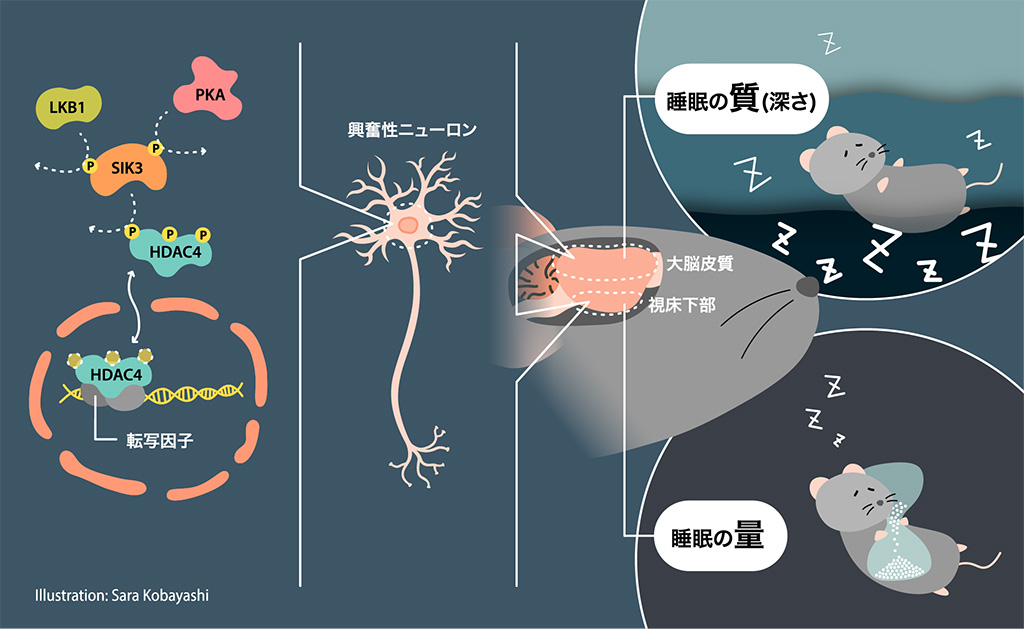
リン酸化酵素SIK3が睡眠制御の鍵になることを報告していましたが、SIK3の形成している分子シグナルや、SIK3がどのニューロンタイプを介して睡眠を制御しているのかは不明でした。ランダム変異マウスの睡眠スクリーニングにより樹立されたSleepy2変異家系は、ヒストン脱アセチル化酵素HDAC4に変異が見つかりました。SIK3はHDAC4をリン酸化することから、リン酸化部位の改変等によってSIK3-HDAC4が睡眠制御シグナルを形成していること、さらに上流にLKB1が働いていることも示し、LKB1-SIK3-HDAC4が睡眠制御の細胞内シグナル系を形成していることが示されました。
ニューロンタイプや脳部位特異的にSik3遺伝子やHdac4遺伝子を操作することによって、SIK3シグナルが主に大脳皮質の興奮性ニューロンを介して睡眠の質を制御し、視床下部の興奮性ニューロンを介して睡眠の量を制御していることが明らかになりました。
ウイルスベクターを用いて後天的に睡眠の量と質を変化させることにも成功しています。
IIISおよび北京生命科学研究所のQinghua Liu研究室との共同研究です。
We previously reported that a kinase SIK3 is a key regulator of sleep, but the molecular pathway formed by SIK3 and through which neuron type SIK3 regulates sleep were unknown. Sleepy2 mutant predigree established through sleep screening of randomly mutagenized mice were found to have a splice mutation in the histone deacetylase HDAC4. Based on the finding that SIK3 phosphorylates HDAC4, we performed a series of experiments to show that SIK3-HDAC4 forms a sleep control signal. Furthermore, LKB1 was shown to function upstream of SIK3, indicating that LKB1-SIK3-HDAC4 forms an intracellular signaling system for sleep regulation.
Neuron type- and brain region-specific genetic manipulations revealed that SIK3 signaling regulates sleep quality primarily via excitatory neurons in the cortex and sleep quantity via excitatory neurons in the hypothalamus.
We have also successfully used viral vectors to alter the quantity and quality of sleep in an acquired manner.
This is collaboration with Qinghu Liu lab in IIIS and NIBS.
Kim et al. Nature 2022 🔗
Zhou et al. Nature 2022 🔗

リン酸化酵素SIK3が睡眠制御の鍵になることを報告していましたが、SIK3の形成している分子シグナルや、SIK3がどのニューロンタイプを介して睡眠を制御しているのかは不明でした。ランダム変異マウスの睡眠スクリーニングにより樹立されたSleepy2変異家系は、ヒストン脱アセチル化酵素HDAC4に変異が見つかりました。SIK3はHDAC4をリン酸化することから、リン酸化部位の改変等によってSIK3-HDAC4が睡眠制御シグナルを形成していること、さらに上流にLKB1が働いていることも示し、LKB1-SIK3-HDAC4が睡眠制御の細胞内シグナル系を形成していることが示されました。
ニューロンタイプや脳部位特異的にSik3遺伝子やHdac4遺伝子を操作することによって、SIK3シグナルが主に大脳皮質の興奮性ニューロンを介して睡眠の質を制御し、視床下部の興奮性ニューロンを介して睡眠の量を制御していることが明らかになりました。
ウイルスベクターを用いて後天的に睡眠の量と質を変化させることにも成功しています。
IIISおよび北京生命科学研究所のQinghua Liu研究室との共同研究です。
We previously reported that a kinase SIK3 is a key regulator of sleep, but the molecular pathway formed by SIK3 and through which neuron type SIK3 regulates sleep were unknown. Sleepy2 mutant predigree established through sleep screening of randomly mutagenized mice were found to have a splice mutation in the histone deacetylase HDAC4. Based on the finding that SIK3 phosphorylates HDAC4, we performed a series of experiments to show that SIK3-HDAC4 forms a sleep control signal. Furthermore, LKB1 was shown to function upstream of SIK3, indicating that LKB1-SIK3-HDAC4 forms an intracellular signaling system for sleep regulation.
Neuron type- and brain region-specific genetic manipulations revealed that SIK3 signaling regulates sleep quality primarily via excitatory neurons in the cortex and sleep quantity via excitatory neurons in the hypothalamus.
We have also successfully used viral vectors to alter the quantity and quality of sleep in an acquired manner.
This is collaboration with Qinghu Liu lab in IIIS and NIBS.
